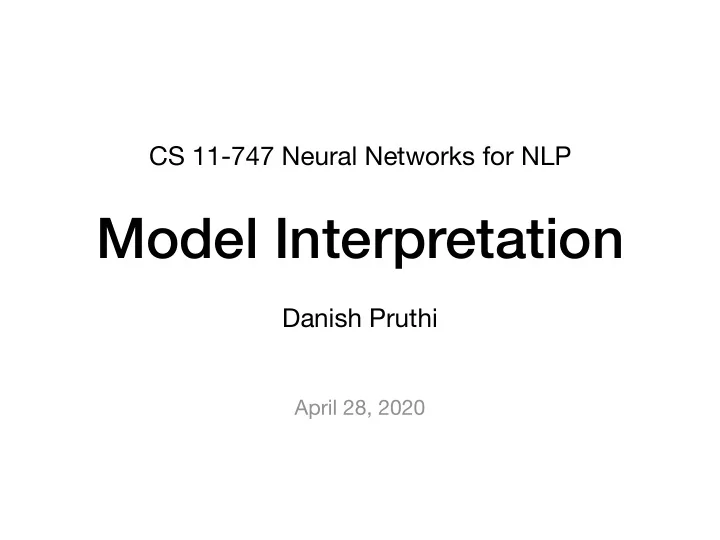

CS 11-747 Neural Networks for NLP Model Interpretation Danish Pruthi April 28, 2020
Why interpretability? • Task: predict probability of death for patients with pneumonia • Why : so that high-risk patients can be admitted, low risk patients can be treated as outpatients • AUC Neural networks > AUC Logistic Regression • Rule based classifier HasAsthma(X) —> LowerRisk(X) more intensive care Example from Caruana et al.
Why interpretability? • Legal reasons: uninterpretable models are banned! — GDPR in EU necessitates "right to explanation" • Distribution shift: deployed model might perform poorly in the wild • User adoption: users happier with explanations • Better Human-AI interaction and control • Debugging machine learning models
Dictionary definition Only if we could understand model.ckpt As per Merriam Webster, accessed on 02/25
Two broad themes global interpretation • What is the model learning? • Can we explain the outcome in "understandable terms"? local interpretation
Comparing two directions Explain the prediction What is the model learning? • Input: a model M, a • Input: a model M, a test (linguistic) property P example X • Output: extent to which M • Output: an explanation E captures P • Techniques: classification, • Techniques: varied … regression • Evaluation: implicit • Evaluation: complicated
What is the model learning?
Source Syntax in NMT 5 syntactic properties Does String-Based Neural MT Learn Source Syntax? Shi et al. EMNLP 2016
Source Syntax in NMT Does String-Based Neural MT Learn Source Syntax? Shi et al. EMNLP 2016
Why neural translations are the right length? Note: LSTMs can learn to count, whereas GRUs can not do unbounded counting (Weiss et al. ACL 2018) Shi et al. EMNLP 2016
Fine grained analysis of sentence embeddings • Sentence representations: word vector averaging, hidden states of the LSTM • Auxiliary Tasks: predicting length, word order, content • Findings: - hidden states of LSTM capture to a great deal length, word order and content - word vector averaging (CBOW) model captures content, length (!), word order (!!) Adi et al. ICLR 2017
Fine grained analysis of sentence embeddings
What you can cram into a single vector: Probing sentence embeddings for linguistic properties • "you cannot cram the meaning of a whole %&!$# sentence into a single $&!#* vector" — Ray Mooney • Design 10 probing tasks: len, word content, bigram shift, tree depth, top constituency, tense, subject number, object number, semantically odd man out, coordination inversion • Test BiLSTM last, BiLSTM max, Gated ConvNet encoder Conneau et al. ACL 2018
Issues with probing Hewitt et al. 2019
Issues with probing Hewitt et al. 2019
Minimum Description Length (MDL) Probes • Characterizes both probe quality and the amount of e ff ort needed to achieve it • More informative and stable Voita et al. 2020
Summary: What is the model learning? https://boknilev.github.io/nlp-analysis-methods/table1.html
Explain the prediction
How to evaluate? Training Phase Test Phase Input x Some x, f(x) pairs Predict f(x) Input x Some x, f(x), E triples Predict f(x)
Explanation Technique: LIME Ribeiro et al, KDD 2016
Explanation Technique: Influence Functions • What would happen if a given training point didn’t exist? • Retraining the network is prohibitively slow, hence approximate the e ff ect using influence functions. Most influential train images Koh & Liang, ICML 2017
Explanation Technique: Attention Entailment Image captioning Rocktäschel et al, 2015 Xu et al, 2015 Document classification BERTViz Yang et al, 2016 Vig et al, 2019
Explanation Technique: Attention 1. Attention is only mildly correlated with other importance score techniques 2. Counterfactual attention weights should yield different predictions, but they do not
"Attention might be an explanation." • Attention scores can provide a (plausible) explanation not the explanation. • Attention is not explanation if you don’t need it • Agree that attention is indeed manipulable, "this should provide pause to researchers who are looking to attention distributions for one true, faithful interpretation of the link their model has established between inputs and outputs."
• Manipulated models perform better than no-attention models • Elucidate some workarounds (what happens behind the scenes)
Explanation Techniques: gradient based importance scores Figure from Ancona et al, ICLR 2018
Explanation Technique: Extractive Rationale Generation Key idea : find minimal span(s) of text that can (by themselves) explain the prediction • Generator (x) outputs a probability distribution of each word being the rational • Encoder (x) predicts the output using the snippet of text x • Regularization to support contiguous and minimal spans
Future Directions • Need automatic methods to evaluate interpretations • Complete the feedback loop: update the model based on explanations
Thank You! Questions?
Recommend
More recommend